The Investigation of Underwater Wireless Optical Communication Links Using the Total Reflection at the Air-Water Interface in the Presence of Waves
Abstract
:1. Introduction
2. Materials and Methods
3. Results and Discussion
3.1. Characteristic of InGaN-Based Micro-LED
3.2. Selection of Total Reflection Angle
3.3. Research on Wave Frequencies
3.4. Research on Wave Amplitudes
4. Conclusions
Author Contributions
Funding
Institutional Review Board Statement
Informed Consent Statement
Data Availability Statement
Acknowledgments
Conflicts of Interest
References
- Wei, Z.; Mao, S.; Li, Z.; Pepe, A.; Zhang, L.; Liu, X.; Chen, Y.; Dong, Y.; Fu, H.Y. Propagation analysis and experiment of near-infrared VCSEL-based diffuse optical wireless communication. Appl. Opt. 2020, 59, 6094–6101. [Google Scholar] [CrossRef] [PubMed]
- Burchardt, H.; Serafimovski, N.; Tsonev, D.; Videv, S.; Haas, H. VLC: Beyond point-to-point communication. IEEE Commun. Mag. 2014, 52, 98–105. [Google Scholar] [CrossRef]
- Song, A.; Stojanovic, M.; Chitre, M. Editorial Underwater Acoustic Communications: Where We Stand and What Is Next? IEEE J. Ocean. Eng. 2019, 44, 1–6. [Google Scholar]
- Palmeiro, A.; Martin, M.; Crowther, I.; Rhodes, M. Underwater Radio Frequency Communication. In Proceedings of the OCEANS 2011 IEEE-Spain, Santander, Spain, 6 June 2011; pp. 1–8. [Google Scholar]
- Chaitanya, D.E.; Sridevi, C.V.; Rao, G.S.B. Path Loss Analysis of Underwater Communication Systems. In Proceedings of the IEEE Technology Students’ Symposium, Kharagpur, India, 14–16 January 2011; pp. 65–70. [Google Scholar]
- Oubei, H.M.; Shen, C.; Kammoun, A.; Zedini, E.; Park, K.; Sun, X.; Liu, G.; Kang, C.; Ng, T.K.; Alouini, M.; et al. Light Based Underwater Wireless Communications. Jpn. J. Appl. Phys. 2018, 57, 8. [Google Scholar] [CrossRef]
- Zeng, Z.; Fu, S.; Zhang, H.; Dong, Y.; Cheng, J. A Survey of Underwater Optical Wireless Communications. IEEE Commun. Surv. Tutor. 2017, 19, 204–238. [Google Scholar] [CrossRef]
- Frank, H.; Radic, S. High bandwidth underwater optical communication. Appl. Opt. 2008, 47, 277–283. [Google Scholar]
- Arnon, S. Underwater optical wireless communication network. Opt. Eng. 2010, 49, 015001. [Google Scholar] [CrossRef]
- Farr, N.; Bowen, A.; Ware, J.; Pontbriand, C.; Tivey, M. An integrated, underwater optical/acoustic communications system. In Proceedings of the OCEANS’10 IEEE SYDNEY, Sydney, Australia, 24–27 May 2010; pp. 1–6. [Google Scholar]
- Elibol, A.; Garcia, R.; Gracias, N. A new global alignment approach for underwater optical mapping. Ocean Eng. 2011, 38, 1207–1219. [Google Scholar] [CrossRef]
- Domingo, M.C. An Overview of the Internet of Underwater Things. J. Netw. Comput. Appl. 2012, 35, 1879–1890. [Google Scholar] [CrossRef]
- Jamali, M.V.; Mirani, A.; Parsay, A.; Abolhassani, B.; Nabavi, P.; Chizari, A.; Khorramshahi, P.; Abdollahramezani, S.; Salehi, J.A. Statistical Studies of Fading in Underwater Wireless Optical Channels in the Presence of Air Bubble, Temperature, and Salinity Random Variations. IEEE Trans. Commun. 2018, 66, 4706–4723. [Google Scholar] [CrossRef]
- Oubei, H.M.; ElAfandy, R.T.; Park, K.; Ng, T.K.; Alouini, M.; Ooi, B.S. Performance Evaluation of Underwater Wireless Optical Communications Links in the Presence of Different Air Bubble Populations. IEEE Photonics J. 2017, 9, 7903009. [Google Scholar] [CrossRef] [Green Version]
- Elamassie, M.; Uysal, M. Performance Characterization of Vertical Underwater VLC Links in the Presence of Turbulence. In Proceedings of the 11th IEEE/IET International Symposium on Communication Systems, Networks Digital Signal Processing (CSNDSP18), Budapest, Hungary, 18–20 July 2018; pp. 1–6. [Google Scholar]
- Yi, X.; Li, Z.; Liu, Z. Underwater Optical Communication Performance for Laser Beam Propagation through Weak Oceanic Turbulence. Appl. Opt. 2015, 54, 1273–1278. [Google Scholar] [CrossRef]
- He, G.; Lv, Z.; Qiu, C.; Liu, Z. Performance Evaluation of 520nm Laser Diode Underwater Wireless Optical Communication Systems in the Presence of Oceanic Turbulence. In Proceedings of the SID International Symposium Digest of Technical Papers, Wuhan, China, 11–14 October 2020; Volume 51, pp. 47–50. [Google Scholar]
- Lu, Z.; Tian, P.; Chen, H.; Izak, B.; Fu, H.; Huang, X.; Jossue, M.; Fan, Y.; Wang, H.; Liu, X.; et al. Active Tracking System for Visible Light Communication Using a GaN-based micro-LED and NRZ-OOK. Opt. Express 2017, 25, 17971–17981. [Google Scholar] [CrossRef] [PubMed]
- Lv, Z.; He, G.; Qiu, C.; Fan, Y.; Wang, H.; Liu, Z. CMOS monolithic photodetector with a built-in 2-dimensional light direction sensor for laser diode based underwater wireless optical communications. Opt. Express 2021, 29, 16197–16204. [Google Scholar] [CrossRef]
- Anous, N.; Abdallah, M.; Uysal, M.; Qaraqe, K. Performance Evaluation of LOS and NLOS Vertical Inhomogeneous Links in Underwater Visible Light Communications. IEEE Access 2018, 6, 22408–22420. [Google Scholar] [CrossRef]
- Kedar, D.; Arnon, S. Non-line-of-sight optical wireless sensor network operating in multiscattering channel. Appl. Opt. 2006, 45, 8454–8461. [Google Scholar] [CrossRef]
- Marraccini, P.J.; Riza, N.A. Smart multiple-mode indoor optical wireless design and multimode light source smart energy-efficient links. Ocean Eng. 2013, 52, 055001. [Google Scholar] [CrossRef]
- Yuan, R.; Ma, J. Review of ultraviolet non-line-of-sight communication. China Commun. 2016, 13, 63–75. [Google Scholar] [CrossRef]
- Zhang, X.; Cao, Z.; Li, J.; Ge, D.; Chen, Z.; Vellekoop, I.M.; Koonen, A.M.J. Wide-coverage beam-steered 40-Gbit/s non-line-of-sight optical wireless connectivity for Industry 4.0. J. Light. Technol. 2020, 38, 6801–6806. [Google Scholar] [CrossRef]
- Jagadeesh, V.K.; Choudhary, A.; Bui, F.M.; Muthuchidambaranathan, P. Characterization of Channel Impulse Responses for NLOS Underwater Wireless Optical Communications. In Proceedings of the 2014 Fourth International Conference on Advances in Computing and Communications, Delhi, India, 24–25 May 2014; pp. 77–79. [Google Scholar]
- Lu, Z.; Tian, P.; Fu, H.; Jossue, M.; Huang, X.; Chen, H.; Zhang, X.; Liu, X.; Liu, R.; Zheng, L.; et al. Experimental Demonstration of Non-line-of-sight Visible Light Communication with Different Reflecting Materials Using a GaN-based micro-LED and Modified IEEE 802.11ac. AIP Adv. 2018, 8, 105017. [Google Scholar] [CrossRef] [Green Version]
- Sun, X.; Cai, W.; Alkhazragi, O.; Ooi, E.; He, H.; Chaaban, A.; Shen, C.; Oubei, H.M.; Khan, M.Z.M.; Ng, T.K.; et al. 375-nm Ultraviolet-laser Based Non-line-of-sight Underwater Optical Communication. Opt. Express 2018, 26, 12870–12877. [Google Scholar] [CrossRef]
- Sun, X.; Kong, M.; Alkhazragi, O.; Shen, C.; Ooi, E.; Zhang, X.; Buttner, U.; Ng, T.K.; Ooi, B.S. Non-line-of-sight Methodology for High-speed Wireless Optical Communication in Highly Turbid Water. Opt. Commun. 2020, 461, 125264. [Google Scholar] [CrossRef]
- Tang, S.; Dong, Y.; Zhang, X. On Path Loss of NLOS Underwater Wireless Optical Communication Links. In Proceedings of the 2013 MTS/IEEE OCEANS, Bergen, Norway, 10–14 June 2013; pp. 1–3. [Google Scholar]
- Liu, W.; Zou, D.; Xu, Z.; Yu, J. Non-line-of-sight scattering channel modeling for underwater optical wireless communication. In Proceedings of the IEEE International Conference on Cyber Technology in Automation, Shenyang, China, 8–12 June 2015; pp. 1265–1268. [Google Scholar]
- Liu, Z.; Lin, C.; Hyun, B.; Sher, C.; Lv, Z.; Luo, B.; Jiang, F.; Wu, T.; Ho, C.; Kuo, H.; et al. Micro-light-emitting diodes with quantum dots in display technology. Light-Sci. Appl. 2020, 9, 83. [Google Scholar] [CrossRef]
- Arvanitakis, G.N.; Bian, R.; McKendry, J.J.D.; Cheng, C.; Xie, E.; He, X.; Yang, G.; Islim, M.S.; Purwita, A.A.; Gu, E.; et al. Gb/s Underwater Wireless Optical Communications Using Series-Connected GaN micro-LED Arrays. IEEE Photonics J. 2020, 12, 1–10. [Google Scholar] [CrossRef]
- Liu, X.; Tian, P.; Wei, Z.; Yi, S.; Huang, Y.; Zhou, X.; Qiu, Z.; Hu, L.; Fang, Z.; Cong, C.; et al. Gbps Long-Distance Real-Time Visible Light Communications Using a High-Bandwidth GaN-Based micro-LED. IEEE Photonics J. 2017, 9, 7204909. [Google Scholar] [CrossRef]
- Fu, H.; Lu, Z.; Zhao, Y. Analysis of Low Efficiency Droop of Semipolar InGaN Quantum Well Light-emitting Diodes by Modified Rate Equation with Weak Phase-space Filling Effect. AIP Adv. 2016, 6, 65013. [Google Scholar] [CrossRef]
- Pan, C.; Yan, Q.; Fu, H.; Zhao, Y.; Wu, Y.; Walle, C.V.D.; Nakamura, S.; DenBaars, S.P. High Optical Power and Low-efficiency Droop Blue Light-emitting Diodes Using Compositionally Step-graded InGaN Barrier. Electron. Lett. 2015, 51, 1187–1189. [Google Scholar] [CrossRef] [Green Version]
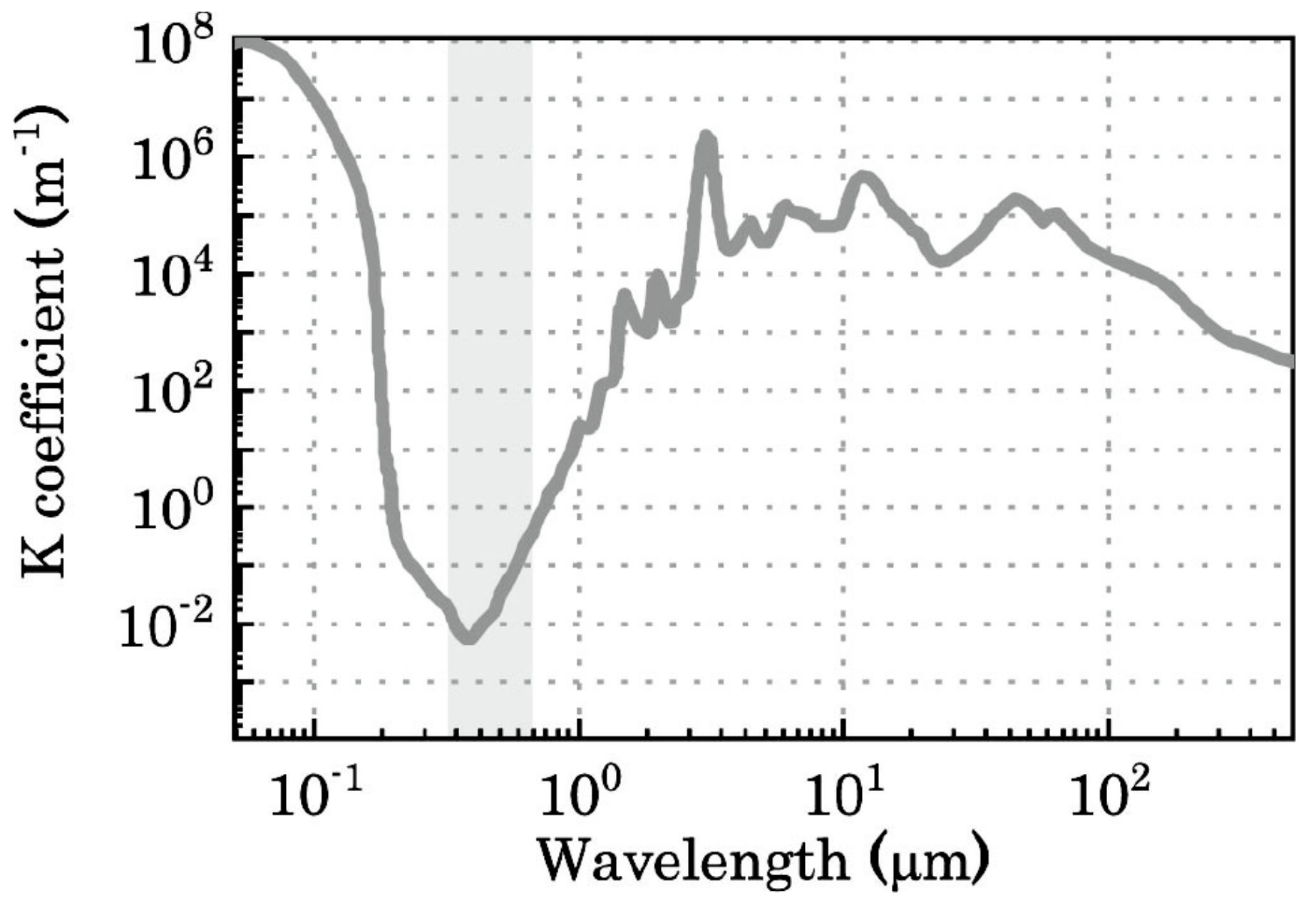


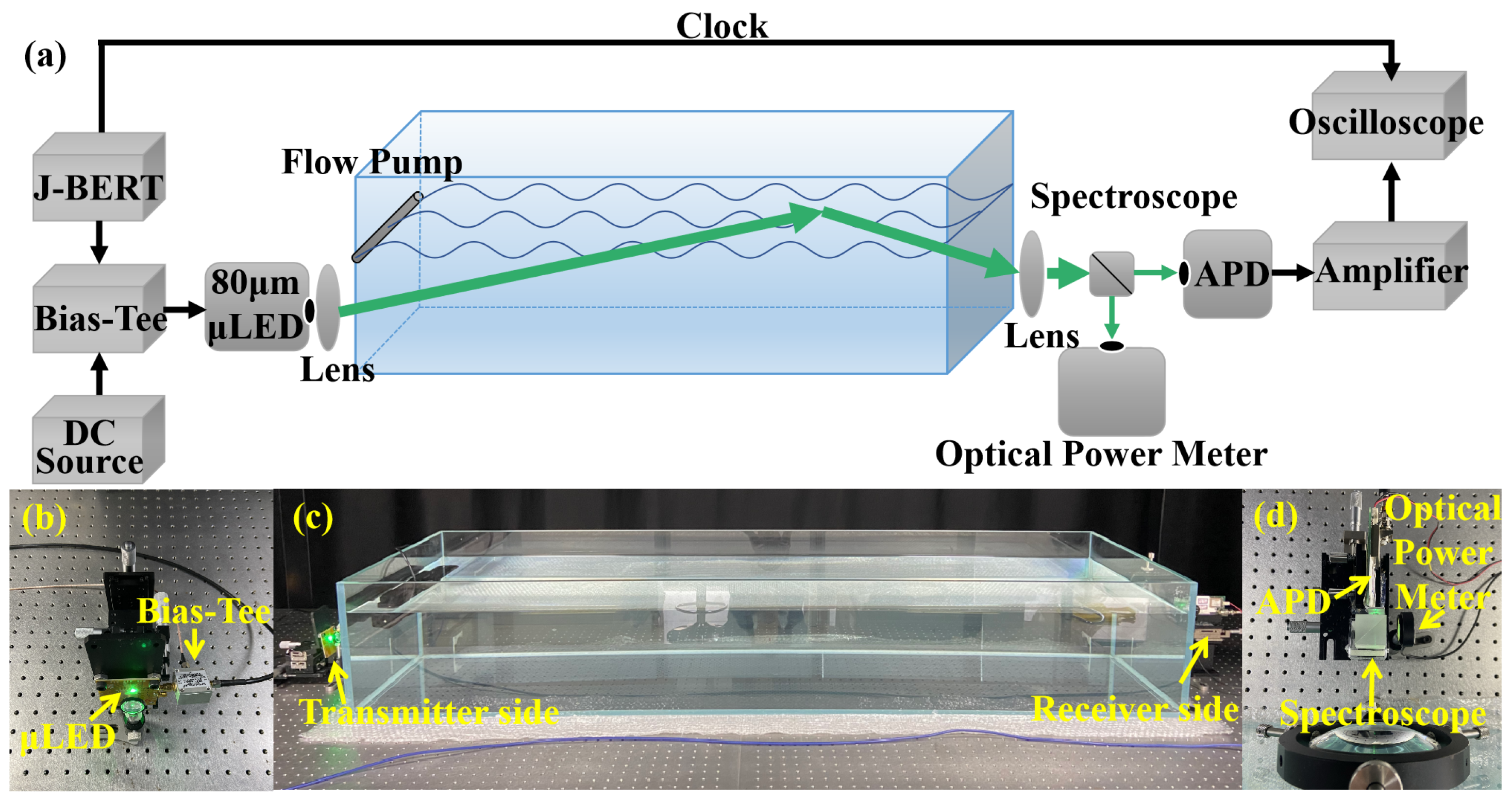
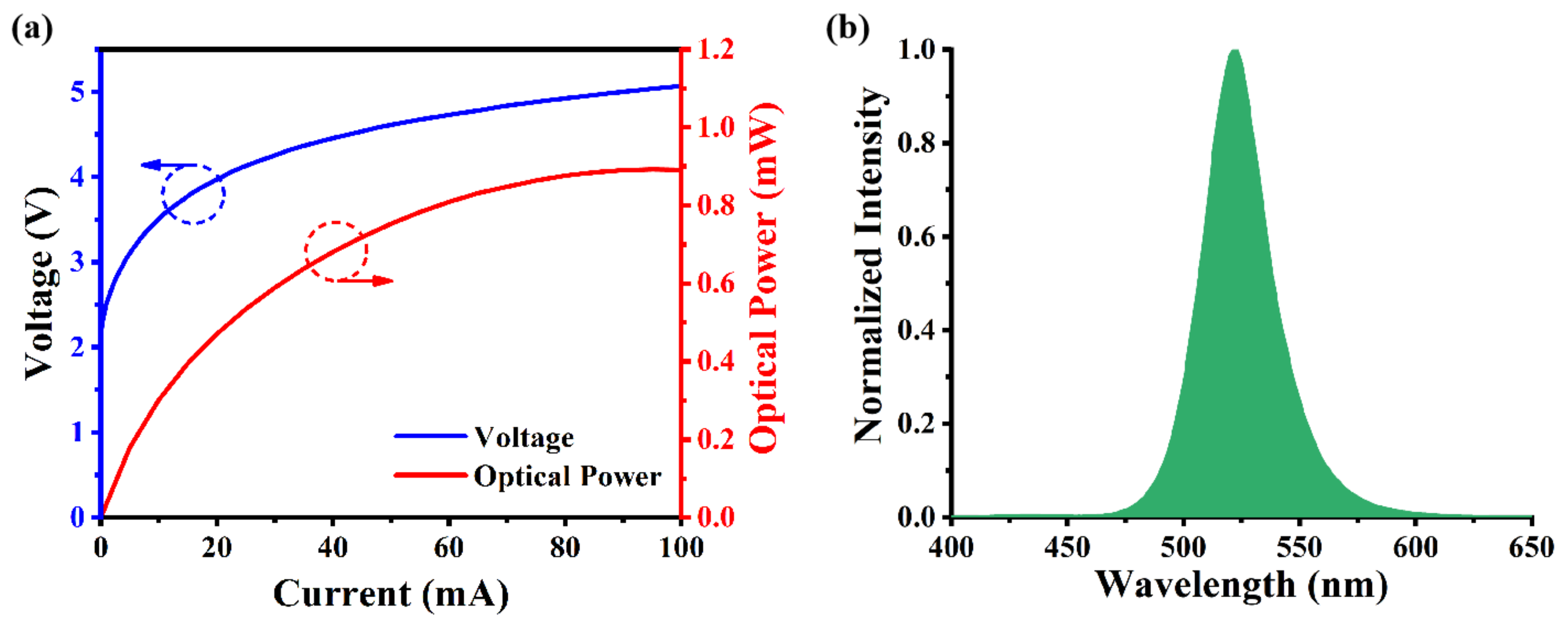

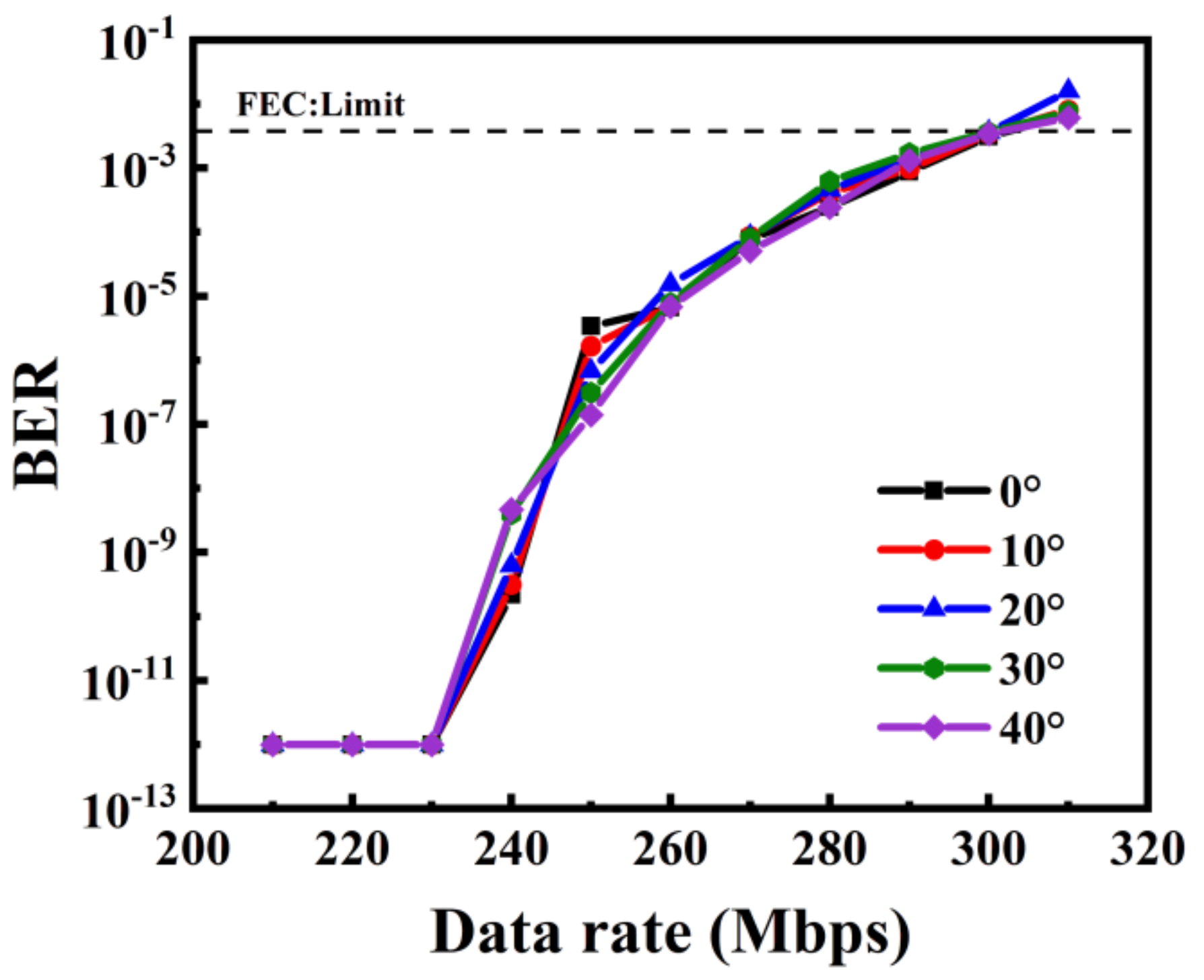

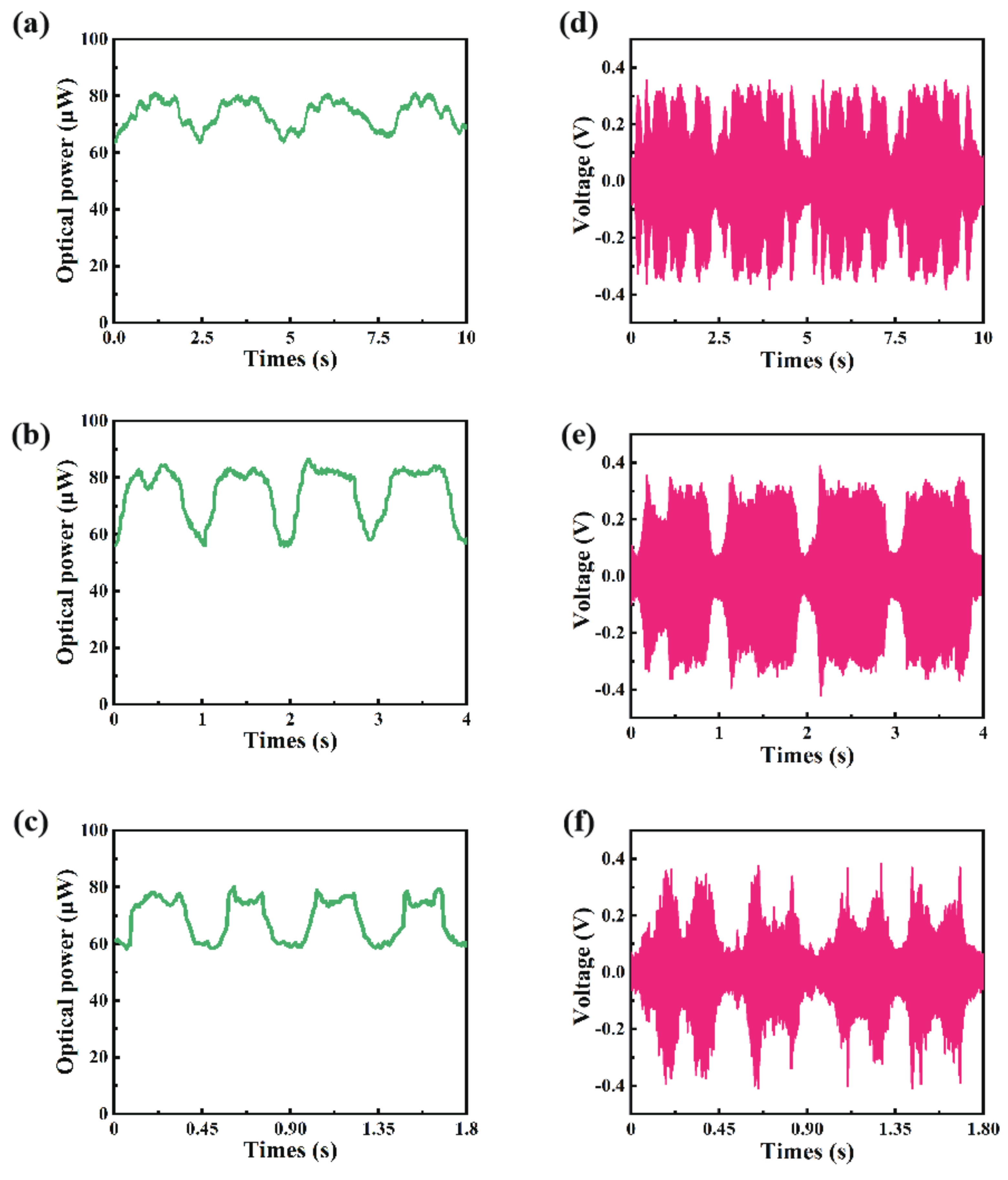

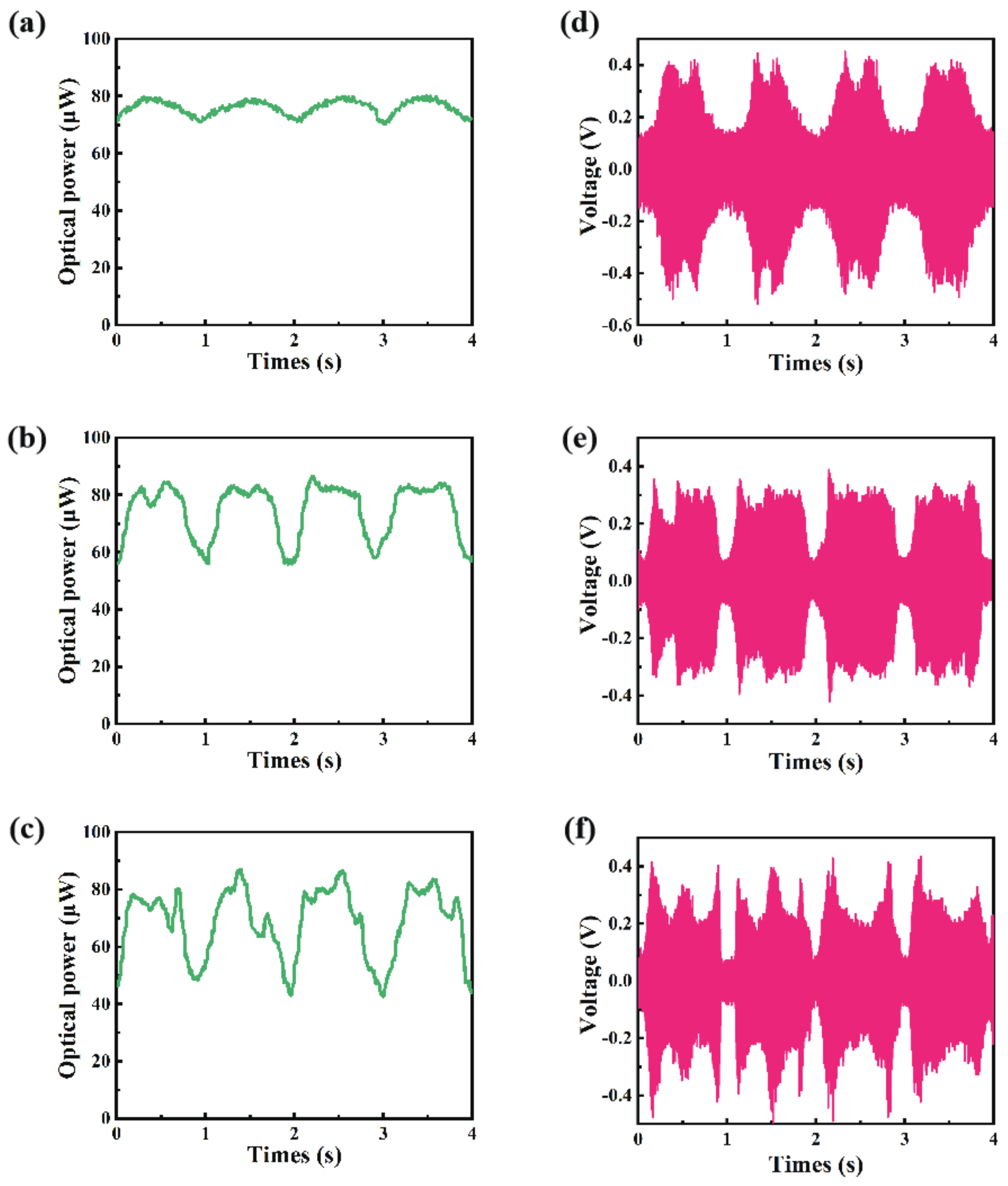
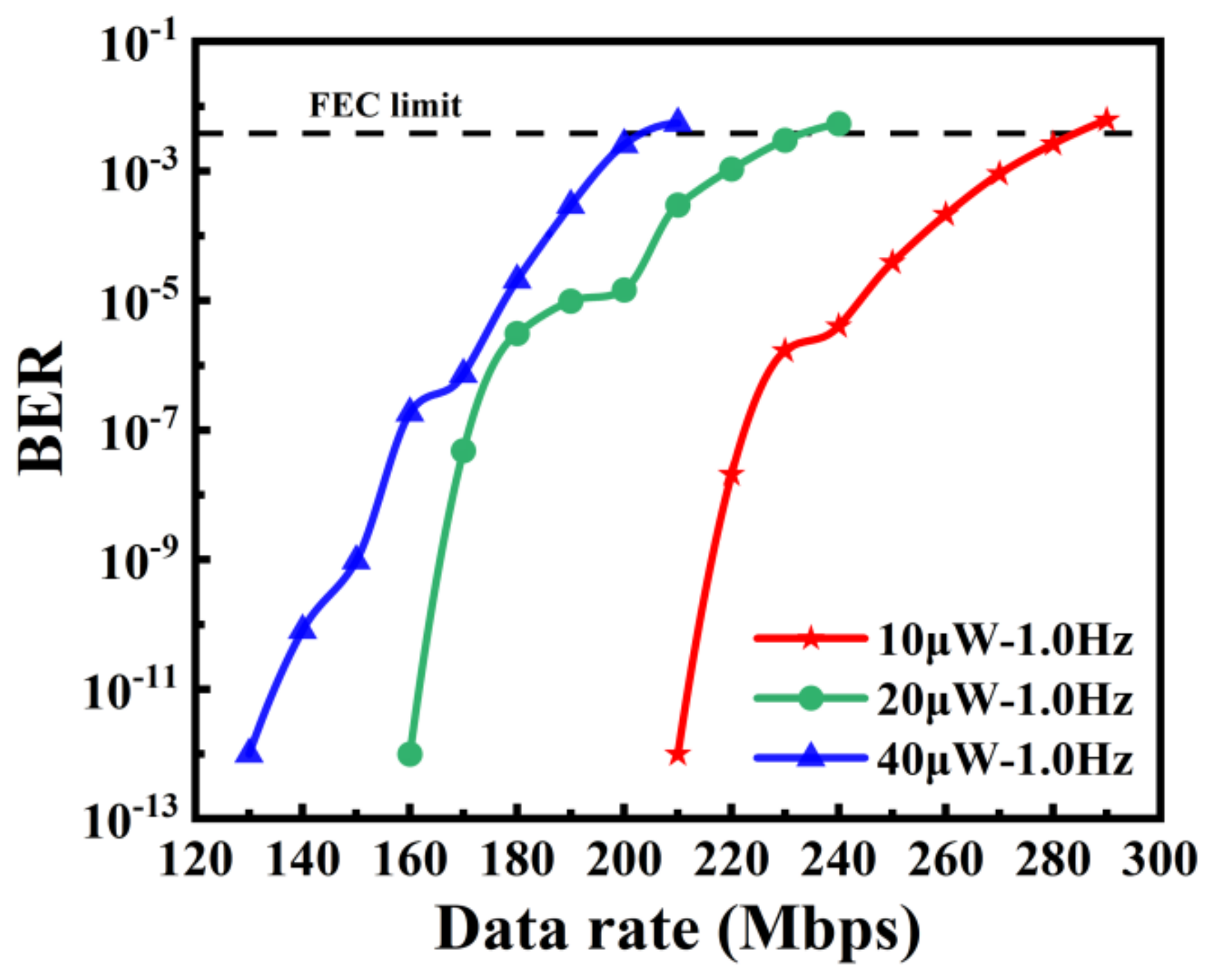
Publisher’s Note: MDPI stays neutral with regard to jurisdictional claims in published maps and institutional affiliations. |
© 2022 by the authors. Licensee MDPI, Basel, Switzerland. This article is an open access article distributed under the terms and conditions of the Creative Commons Attribution (CC BY) license (https://creativecommons.org/licenses/by/4.0/).
Share and Cite
Lv, Z.; He, G.; Yang, H.; Chen, R.; Li, Y.; Zhang, W.; Qiu, C.; Liu, Z. The Investigation of Underwater Wireless Optical Communication Links Using the Total Reflection at the Air-Water Interface in the Presence of Waves. Photonics 2022, 9, 525. https://doi.org/10.3390/photonics9080525
Lv Z, He G, Yang H, Chen R, Li Y, Zhang W, Qiu C, Liu Z. The Investigation of Underwater Wireless Optical Communication Links Using the Total Reflection at the Air-Water Interface in the Presence of Waves. Photonics. 2022; 9(8):525. https://doi.org/10.3390/photonics9080525
Chicago/Turabian StyleLv, Zhijian, Gui He, Hang Yang, Rui Chen, Yuxin Li, Wenwei Zhang, Chengfeng Qiu, and Zhaojun Liu. 2022. "The Investigation of Underwater Wireless Optical Communication Links Using the Total Reflection at the Air-Water Interface in the Presence of Waves" Photonics 9, no. 8: 525. https://doi.org/10.3390/photonics9080525
APA StyleLv, Z., He, G., Yang, H., Chen, R., Li, Y., Zhang, W., Qiu, C., & Liu, Z. (2022). The Investigation of Underwater Wireless Optical Communication Links Using the Total Reflection at the Air-Water Interface in the Presence of Waves. Photonics, 9(8), 525. https://doi.org/10.3390/photonics9080525





